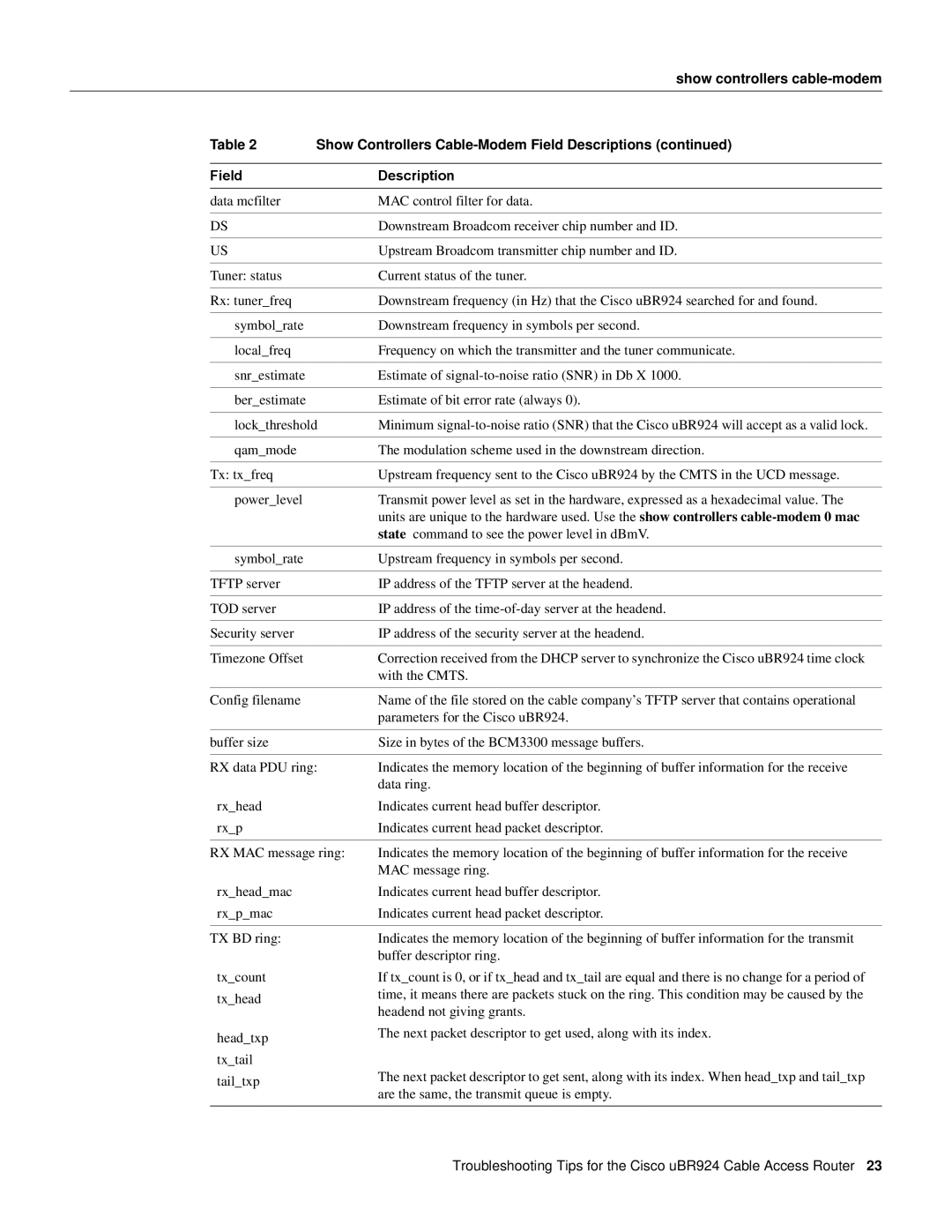|
|
| show controllers |
| Table 2 | Show Controllers | |
|
|
|
|
| Field |
| Description |
|
|
|
|
| data mcfilter |
| MAC control filter for data. |
|
|
|
|
| DS |
| Downstream Broadcom receiver chip number and ID. |
|
|
|
|
| US |
| Upstream Broadcom transmitter chip number and ID. |
|
|
|
|
| Tuner: status |
| Current status of the tuner. |
|
|
|
|
| Rx: tuner_freq |
| Downstream frequency (in Hz) that the Cisco uBR924 searched for and found. |
|
|
|
|
| symbol_rate |
| Downstream frequency in symbols per second. |
|
|
|
|
| local_freq |
| Frequency on which the transmitter and the tuner communicate. |
|
|
|
|
| snr_estimate |
| Estimate of |
|
|
|
|
| ber_estimate |
| Estimate of bit error rate (always 0). |
|
|
| |
| lock_threshold | Minimum | |
|
|
|
|
| qam_mode |
| The modulation scheme used in the downstream direction. |
|
|
|
|
| Tx: tx_freq |
| Upstream frequency sent to the Cisco uBR924 by the CMTS in the UCD message. |
|
|
|
|
| power_level |
| Transmit power level as set in the hardware, expressed as a hexadecimal value. The |
|
|
| units are unique to the hardware used. Use the show controllers |
|
|
| state command to see the power level in dBmV. |
|
|
|
|
| symbol_rate |
| Upstream frequency in symbols per second. |
|
|
|
|
| TFTP server |
| IP address of the TFTP server at the headend. |
|
|
|
|
| TOD server |
| IP address of the |
|
|
|
|
| Security server |
| IP address of the security server at the headend. |
|
|
|
|
| Timezone Offset |
| Correction received from the DHCP server to synchronize the Cisco uBR924 time clock |
|
|
| with the CMTS. |
|
|
|
|
| Config filename |
| Name of the file stored on the cable company’s TFTP server that contains operational |
|
|
| parameters for the Cisco uBR924. |
|
|
|
|
| buffer size |
| Size in bytes of the BCM3300 message buffers. |
|
|
| |
| RX data PDU ring: | Indicates the memory location of the beginning of buffer information for the receive | |
|
|
| data ring. |
| rx_head |
| Indicates current head buffer descriptor. |
| rx_p |
| Indicates current head packet descriptor. |
|
|
| |
| RX MAC message ring: | Indicates the memory location of the beginning of buffer information for the receive | |
|
|
| MAC message ring. |
| rx_head_mac |
| Indicates current head buffer descriptor. |
| rx_p_mac |
| Indicates current head packet descriptor. |
|
|
|
|
| TX BD ring: |
| Indicates the memory location of the beginning of buffer information for the transmit |
|
|
| buffer descriptor ring. |
tx_count tx_head
head_txp tx_tail tail_txp
If tx_count is 0, or if tx_head and tx_tail are equal and there is no change for a period of time, it means there are packets stuck on the ring. This condition may be caused by the headend not giving grants.
The next packet descriptor to get used, along with its index.
The next packet descriptor to get sent, along with its index. When head_txp and tail_txp are the same, the transmit queue is empty.
Troubleshooting Tips for the Cisco uBR924 Cable Access Router 23
